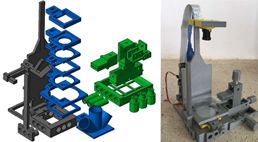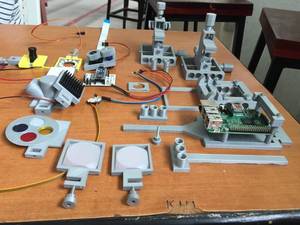DIY Lab Technique to Revolutionise Training for Neuroscientists
 A team of international researchers have come up with an inexpensive way to self-manufacture lab equipment, which could revolutionise the way neuroscientists across the world are trained.
A team of international researchers have come up with an inexpensive way to self-manufacture lab equipment, which could revolutionise the way neuroscientists across the world are trained.
In a study published in the open access journal PLOS Biology, Dr Tom Baden from Sussex Neuroscience and André Maia Chagas, from the University of Tübingen, have devised a new imaging and microscope system called “FlyPi”.
The equipment needed for modern neuroscience experiments can cost tens or even hundreds of thousands of pounds, which often means only institutions in rich countries can undertake top-level research and scientific training.
 A FlyPi fluorescence microscope
A FlyPi fluorescence microscopeBy using the new FlyPi technique, budding neuroscientists will be able to make their own high-performing fluorescence microscopes, using a 3D printer, costing them less than £100.
The new 3D design is based on a framework which holds a Raspberry Pi computer and camera, cheap LEDs for lighting and simple lenses, as well as optical and thermal control circuits based on Arduino, an open-source microcontroller.
More than three years in the making, the model can perform many standard lab protocols, including light and fluorescence microscopy, optogenetics and thermogenetics.

The developers of the FlyPi system share a keen interest in spreading ‘open labware’. Together with co-author Lucia Prieto Godino of the University of Lausanne, the developers have taught courses in 3D printing, programming and DIY lab equipment at universities in Kenya, Uganda, Ghana, Nigeria, South Africa, Sudan and Tanzania.
Dr Baden said: “Many institutions around the world have little money to spend on costly equipment.
“We think it is very important that neuroscientific training and research is opened up to larger numbers of students and junior scientists around the world. We hope that open labware, such as our FlyPi system, offers a starting point.”
- Tags:
- 3D printing
- Andre Maia Chagas
- Arduino
- DIY lab equipment
- fluorescence microscopes
- FlyPi
- Ghana
- Kenya
- Lucia Prieto Godino
- neuroscience
- Nigeria
- Open Access Journal
- open labware
- open-source microcontroller
- PLoS Biology
- Raspberry Pi
- South Africa
- Sudan
- Sussex Neuroscience
- Tanzania
- Tom Baden
- Uganda
- University of Lausanne
- University of Sussex
- University of Tübingen
- Login to post comments